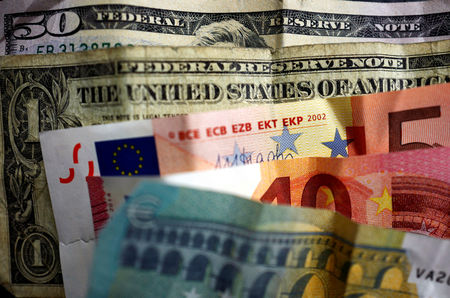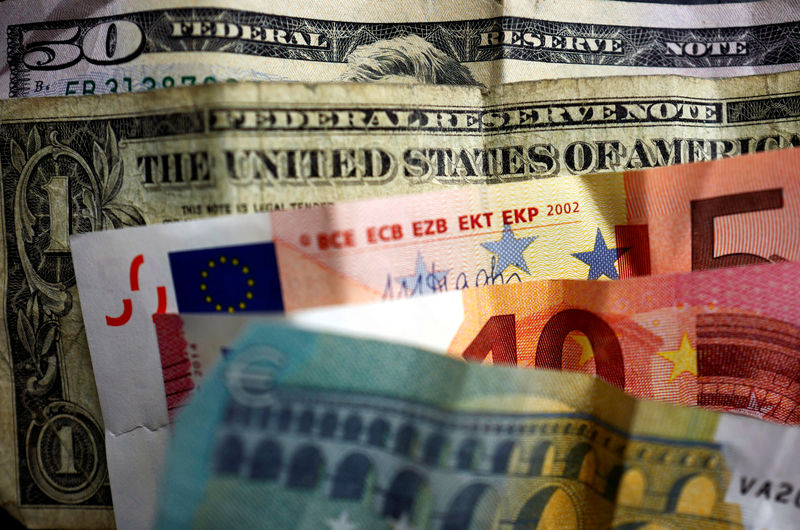
Investing.com – The dollar rose against the euro to levels not seen since November last year. Some analysts believe that further growth is in store for us as the EUR/USD pair could fall towards parity.
At 10:55 ET (1455 GMT), the pair was trading at 1.0690, recovering slightly from Tuesday’s low of 1.0601, the lowest level the pair had fallen to since November 2.
The pair is down about 1% this week alone and is on track to be down 4% year-to-date.
Factors influencing the EUR/USD exchange rate
Escalating geopolitical tensions between Israel and Iran have created a safe haven for the US currency amid fears that Iran’s first-ever direct attack on the State of Israel will lead to a widespread expansion of the conflict between Israel and the Hamas militant group. , which will affect the price of oil in this oil-rich region.
“With the US being among the most energy-independent major economies and also the source of the world’s (high-yielding) reserve currency, it is understandable that the US dollar should benefit from the high risk premiums associated with this conflict,” UBS analysts said. , in a note dated April 17.
However, the main factor contributing to the growth of the dollar not only against the euro, but also against the currencies of most major industrialized countries, is the discrepancy in the economic performance of the respective countries.
“The driving force here is divergence, with strong US data and particularly strong inflation data (three months at 0.4% m/m) meaning the Fed is in no rush to cut rates,” said Chris Turner, global head of the department. markets and Regional Head of Research for the UK and Central and Eastern Europe at ING.
“If at the beginning of the year the market was estimating six Fed rate cuts, now the market is estimating less than two,” he added.
The Fed chairman said Tuesday that recent inflation data has not given policymakers the confidence they need to move to lower interest rates soon.
This contrasts with his comments to a US Senate committee just over five weeks ago that the Fed was “not far away” from gaining such confidence.
In contrast, inflation is moving closer to the European Central Bank’s medium-term target, and the Bundesbank said last month that Germany, the region’s economic powerhouse, is likely to be in recession in the first quarter of 2024 as weak consumption and anemic industrial demand continue to weigh on pressure.
On Thursday they floated a June interest rate cut, arguing that price growth was slowing to 2% and the 20-nation bloc was “not the same” as the United States, which is battling unexpectedly stubborn inflation.
“The ECB is seeking to demonstrate its policy independence by saying that inflation in the eurozone has been supply-side driven (and falling) while the US suffers from harsher demand-side inflation,” Turner said. “Market prices are just over three ECB cuts this year.”
EUR/USD price forecast for 2024
This divergence between Fed and ECB statements is likely to lead to further losses for EUR/USD as ING looks to test the psychological 1.0600 level in the near future.
It seems unlikely there will be strong technical support, the bank added, and the next big support levels could instead lie at 1.0500 and the October low at 1.0450.
“It is important to note that the lack of market movement data and the dollar benefiting from other developments in the foreign exchange market means that a move into the 1.05 area in the near term poses quite a significant risk,” said Francesco Pesole, an analyst at ING.
UBS cut EUR/USD in a note on April 17, forecasting the pair to trade at 1.0500 from 1.1200 at the end of 2024 and at 1.0500 from 1.0900 at the end of the second quarter.
“We suspect that as the ECB begins to cut rates while the Fed lags, the euro will come under further pressure,” the Swiss bank’s analysts said. “The fact that this thesis is widely supported may slow the movement, but it probably won’t reverse it.”
ING maintains a year-end forecast of 1.1000, but “risks are shifting to the downside in EUR/USD – be it from escalation in the Middle East or a Trump presidency, which will be negative for the world and bad for pro-Americans.” cyclical euro.”
Will EUR/USD reach parity?
The pair’s fall to parity is not a widespread central case: ING’s Turner notes that while the divergence in interest rate spreads is the widest since late 2022, when EUR/USD fell below parity, the structural scenario is not as negative.
“Low gas prices mean that terms of trade in the eurozone are in a much better position – and suggest that if the yield differential does push EUR/USD below 1.05 – it shouldn’t stay there for long,” he added. He.
However, UBS said, higher energy prices pose a new risk to the euro’s terms of trade, and there is also the possibility that the US will impose additional tariffs if the Republicans win the presidential election.
That would be “a clear negative, which leaves room for a parity test in the medium term – wider ranges should be expected throughout the year,” the Swiss bank added.
Forex Trading: Find Opportunities in Currency Fluctuations
Forex is the largest and most liquid financial market in the world, with trillions of dollars traded every day.
The foreign exchange market (forex) is a global decentralized market for trading currencies. Although there are high risks for investors trading the Forex market, there are also high potential profits. Learn more about how Forex trading works in our Academy article.


